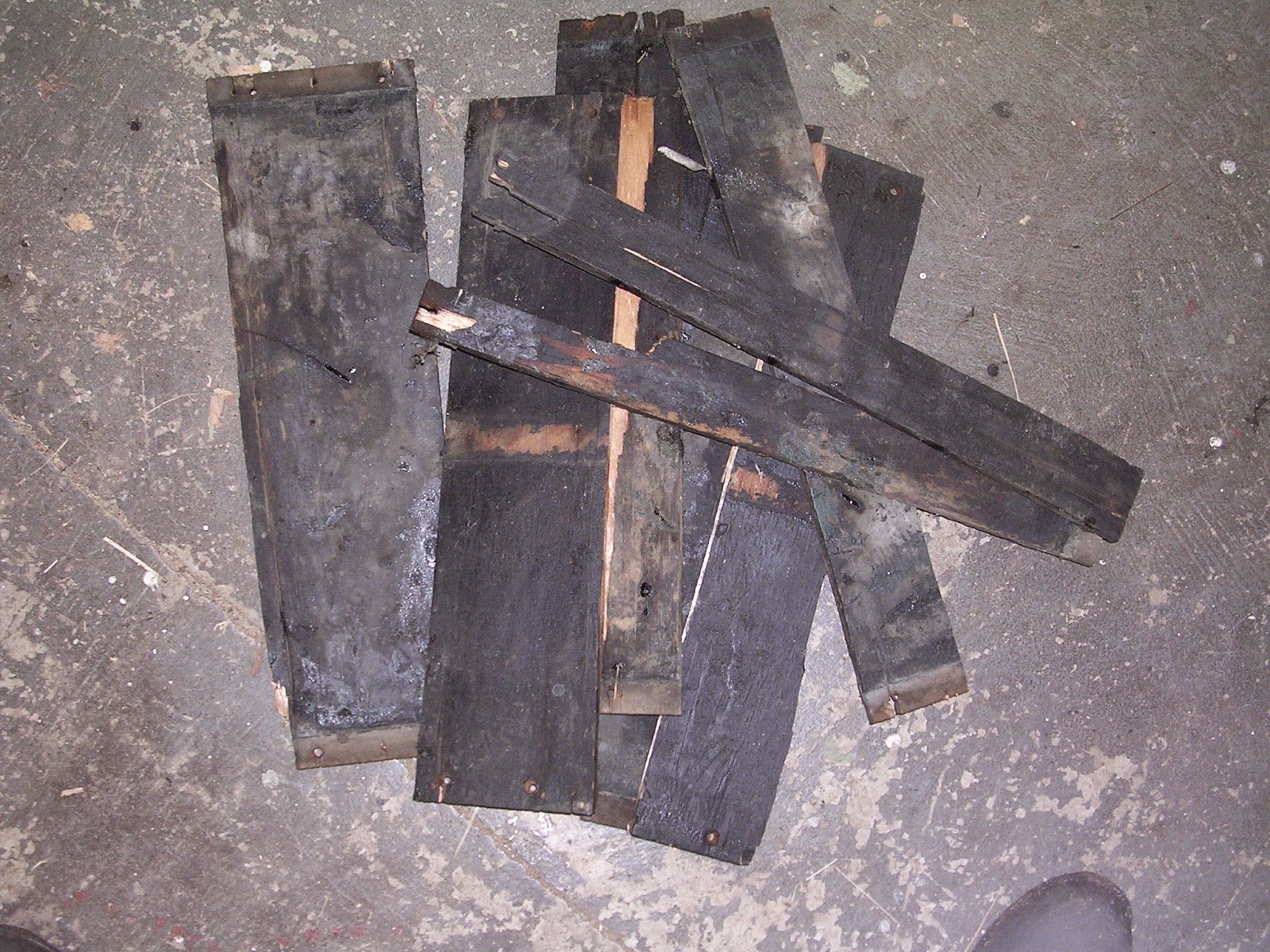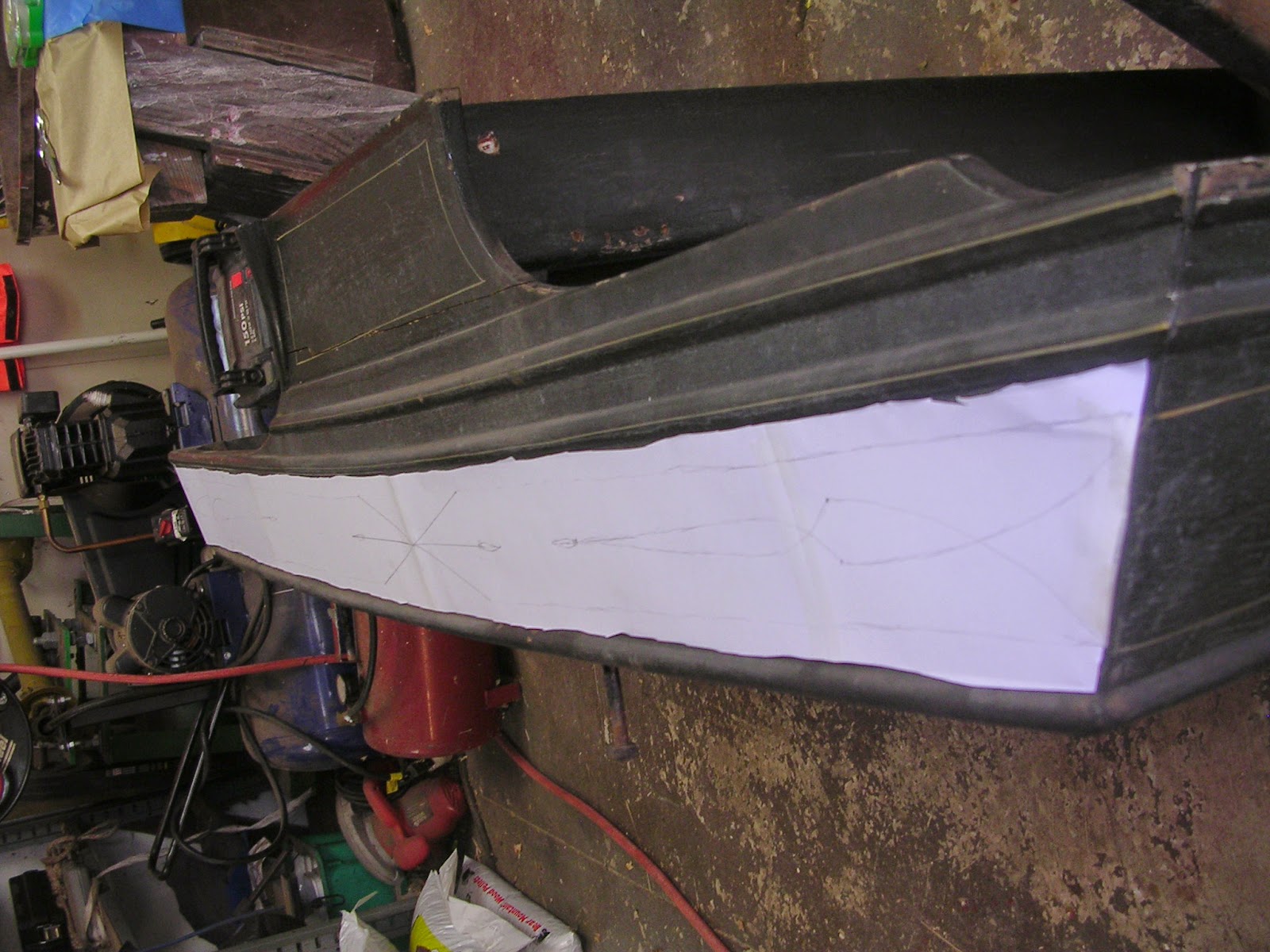But in my mind, the worst is over. The worst part, stripping the paint, was a nightmare because instead of "lifting" the old paint in rippled sheets like I'm used to, the paint stripper turned it into a gummy, sticky glue that had to be ground off the scrapers occasionally with the wire wheel on the bench grinder.
Some areas were much more easily stripped with heat, as shown in a video in my last post. But the molding and the entire inside of the body had to be chemically stripped.
I was just as happy that the floorboards were not salvageable...
...as that meant I could install a shiny new set. These boards require some hand fitting around the edges. I had to ORDER slot head wood screws to install them, because I cannot find them locally. Everything is Phillips head.
Once the paint was off, it was a matter of going over the entire body with 80 grit sandpaper and marking areas that needed repair. Other than the crack in the left seat riser (the right side has already been repaired), most repairs consisted of fixing blemishes, like the "skinned" molding on the bottom front, left side.
Pettit's marine epoxy fairing compound did a fabulous job on these blemishes and I have high expectations as to the permanence of the repair. The stuff is really great to sand and molded beautifully.
There were only four screw heads to fill, and I did my best to clean the heads off as well as possible to insure adhesion. Random nail holes in the seat frame were drilled out a little to get to clean wood, and also filled with fairing compound. These nails held in a makeshift tool box under the seat and as far as I'm concerned they're vandalism!
The left rear corner was the only place where I felt some "structural" repair was required, and I believe it may have been a mismatch when the carriage was originally built...the only one in a gloriously beautiful job. I do not believe this slightly "opened" joint was due to shrinkage. I wanted to join the two panels in this corner permanently (the space had been filled with lead paste, which is why I think it was a built-in flaw), so instead of fairing compound, I used Abatron products. A wood sliver wouldn't "go" because there was a network of small nails that would have prevented a good fit. Again, I have high expectations of repair performance.
The crack in the seat riser was too close to the underside of the seat frame to be able to center a backing strip in this area (it was more accessible throughout the rest of the crack, so the backing strip was used in those places.)
I did a "lamination" repair in this crack, first cleaning it out, then laminating two strips of hardwood veneer into the crack with expanding (moisture curing) glue. Roughness was evened out with fairing compound. You cannot feel this repair with your fingers. Unlike the crack on the right side, the two edges had not moved out of alignment, so did not have to be pulled back together.
Interestingly, I read in the George Isles restoration book that panels like this, which have been tapered (the seat riser is tapered from 3/8" near the crack, to 5/8" at the top) was a prime area for cracks to appear, even when the best materials were used by the best workmen in the best houses.
The first time I did a laminated repair like this was about three years ago, on the hubs of a European carriage. Those cracks have never re-opened.
Once the repairs were completed, the body was sanded again, several times, with finer grit sandpaper, ending up with 220 grit.
It is now resting safely under a coating of clear penetrating sealer, awaiting the next phase, more sanding, priming, and painting!
In the meantime...
The Carriage Museum of America has most graciously consented to letting me excerpt a few passages and sketches from their book Conservation and Restoration of Horse-Drawn Vehicles,
published in 1997.
I am very sad to say that I do not find this book in their bookstore, nor do I find it in the Carriage Assn. of America's bookstore. There was no mention of it being out of print. Neither do I find George Isles' book, The Restoration of Carriages. This is really alarming. We really ARE running out of written guides for the restoration of carriages. If you can find either or both of these books, BUY THEM if you are interested in restoring carriages.
Anyway, in the matter of panel repair, the Carriage Museum offers several options that I haven't had to experiment with on this project because damage to the vehicle was so minimal.
Cabinet Maker's Paneling: Sometimes known as Baltic Birch or Finland Birch, it is a popular substitute for replacing solid wood panels. There is too much information here for me to copy. Perhaps if you are interested, you can search the internet for more information.
Veneering or Skinning: Another choice in dealing with cracked panels is to use a veneer and glue it over the entire panel that is cracked. This is probably an option for some jobs when you do not want to take the whole carriage apart in order to get to a panel to replace it. The veneer can be a number of things, thin aluminum sheeting, Formica, fiberglass and resin. Suggested is to get to the back of the panel to secure it from any further contracting and expanding (as I have done with the seat riser cracks). Grind about a 1 1/2" wide surface on either side of the crack with coarse sandpaper and glue a 3" strip over the crack.
Repairing Panels by Inlaid: You can try routing a half inch wide groove on both sides of the crack, about 1/3 the thickness of your panel and glue in strips of wood that are cut to fit the grooves. Yet another way is to cut a simple V-shaped grove, fit and glue in a strip of wood.
There is a great deal more detail on panel repair in both the aforementioned books. Neither deals in depth with other types of materials such as the Abatron and Pettit products of which I am so fond. Panel cracks can be frustrating to repair permanently. Just remember whatever you do, clean the surface of the wood, removing a sliver if you have to, to assure proper adhesion of whatever products (glue, putty, fiberglass) that you apply.






















